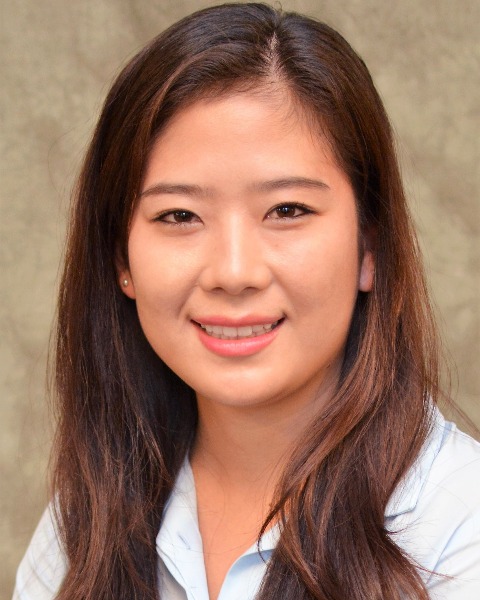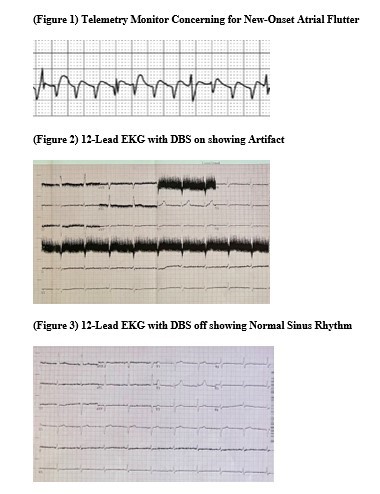Tuesday Poster Session
Category: General Endoscopy
P4130 - Recognizing and Managing Artifact Arrhythmias in the Endoscopy Suite: A Case of New Onset Atrial Flutter During Time out for EGD in a Patient with Celiac Disease and Deep Brain Stimulator for Parkinson’s Disease
Tuesday, October 29, 2024
10:30 AM - 4:00 PM ET
Location: Exhibit Hall E


Tenzin Tseky, DO
Arnot Ogden Medical Center
Elmira, NY
Presenting Author(s)
Award: Presidential Poster Award
Tenzin Tseky, DO, Varun Mehta, MD, Thaddeus Sullivan, DO, Ruru Idahosa, DO, Brian Sowka, DO, Prashant Jadav, DO, Daniel Casas, DO, Gary Valvano, DO, Bruno Mazza, MD
Arnot Ogden Medical Center, Elmira, NY
Introduction: Cardiac telemetry (tele) monitoring is an essential aspect of ensuring a safe endoscopic exam, particularly during sedation. However, readings can be contaminated by a variety of sources from within and without. The advent of devices such as the Deep Brain Stimulator (DBS), an implantable device increasingly used to treat disabling symptoms of neurological disorders including Essential Tremor, Parkinson’s Disease, Dystonia, and OCD will likely lead to gastroenterologists encountering flutter-pattern artifcats in the endoscopy unit. Recognition and management are critical to avoiding unnecessarily canceled procedures and referrals.
Case Description/Methods: A 73-year-old male with past medical history of Parkinson’s Disease status post DBS device, well-controlled Celiac Disease, arrived in his usual state of health to endoscopy department to undergo evaluation for worsening pyrosis. Intake was unremarkable and he was brought to the procedure room. During the time out, a rhythm concerning for atrial flutter was noted on tele monitoring. Endoscopy staff suggested the procedure be canceled, with immediate transfer to emergency department. Patient was noted to be comfortable, hemodynamically stable, and without chest pain or dyspnea. Gastroenterology fellow ordered a 12-lead EKG which revealed multiple leads with artifact waves. DBS device was suspected to the be culprit. At this point, the patient suggested that he can turn off the device without any significant consequence. The 12-lead EKG was repeated and showed resolution of the arrhythmia. Patient was able to proceed with endoscopic procedure without any further events.
Discussion: The phenomenon of “aliasing” is an undersampling error wherein the source frequency (DBS) exceeds that of the sampling frequency (EKG), leading to the low-frequency flutter pattern (Figure 1). The 12-lead EKG has a larger sampling frequency which shows the interference but resolves flutter pattern (Figure 2).
Learning Points in this case: (1) Devices such DBS result in electromagnetic interference, and due to increasing use/indications, endoscopists are bound to encounter flutter-pattern artifacts on tele in the endoscopy suite and should be familiar with troubleshooting. (2) New-onset arrhythmia evaluation should begin with 12-lead EKG after ensuring patient’s clinical stability (3) If able to turn device off safely, repeat 12-lead EKG without signal interference (Figure 3). (3) These steps can prevent unnecessary procedure cancellations and inappropriate referrals.

Disclosures:
Tenzin Tseky, DO, Varun Mehta, MD, Thaddeus Sullivan, DO, Ruru Idahosa, DO, Brian Sowka, DO, Prashant Jadav, DO, Daniel Casas, DO, Gary Valvano, DO, Bruno Mazza, MD. P4130 - Recognizing and Managing Artifact Arrhythmias in the Endoscopy Suite: A Case of New Onset Atrial Flutter During Time out for EGD in a Patient with Celiac Disease and Deep Brain Stimulator for Parkinson’s Disease, ACG 2024 Annual Scientific Meeting Abstracts. Philadelphia, PA: American College of Gastroenterology.
Tenzin Tseky, DO, Varun Mehta, MD, Thaddeus Sullivan, DO, Ruru Idahosa, DO, Brian Sowka, DO, Prashant Jadav, DO, Daniel Casas, DO, Gary Valvano, DO, Bruno Mazza, MD
Arnot Ogden Medical Center, Elmira, NY
Introduction: Cardiac telemetry (tele) monitoring is an essential aspect of ensuring a safe endoscopic exam, particularly during sedation. However, readings can be contaminated by a variety of sources from within and without. The advent of devices such as the Deep Brain Stimulator (DBS), an implantable device increasingly used to treat disabling symptoms of neurological disorders including Essential Tremor, Parkinson’s Disease, Dystonia, and OCD will likely lead to gastroenterologists encountering flutter-pattern artifcats in the endoscopy unit. Recognition and management are critical to avoiding unnecessarily canceled procedures and referrals.
Case Description/Methods: A 73-year-old male with past medical history of Parkinson’s Disease status post DBS device, well-controlled Celiac Disease, arrived in his usual state of health to endoscopy department to undergo evaluation for worsening pyrosis. Intake was unremarkable and he was brought to the procedure room. During the time out, a rhythm concerning for atrial flutter was noted on tele monitoring. Endoscopy staff suggested the procedure be canceled, with immediate transfer to emergency department. Patient was noted to be comfortable, hemodynamically stable, and without chest pain or dyspnea. Gastroenterology fellow ordered a 12-lead EKG which revealed multiple leads with artifact waves. DBS device was suspected to the be culprit. At this point, the patient suggested that he can turn off the device without any significant consequence. The 12-lead EKG was repeated and showed resolution of the arrhythmia. Patient was able to proceed with endoscopic procedure without any further events.
Discussion: The phenomenon of “aliasing” is an undersampling error wherein the source frequency (DBS) exceeds that of the sampling frequency (EKG), leading to the low-frequency flutter pattern (Figure 1). The 12-lead EKG has a larger sampling frequency which shows the interference but resolves flutter pattern (Figure 2).
Learning Points in this case: (1) Devices such DBS result in electromagnetic interference, and due to increasing use/indications, endoscopists are bound to encounter flutter-pattern artifacts on tele in the endoscopy suite and should be familiar with troubleshooting. (2) New-onset arrhythmia evaluation should begin with 12-lead EKG after ensuring patient’s clinical stability (3) If able to turn device off safely, repeat 12-lead EKG without signal interference (Figure 3). (3) These steps can prevent unnecessary procedure cancellations and inappropriate referrals.

Figure: Images showing (Figure 1) Telemetry Monitor Concerning for New-Onset Atrial Flutter, (Figure 2) 12-Lead EKG with DBS on showing Artifact, and (Figure 3) 12-Lead EKG with DBS off showing Normal Sinus Rhythm
Disclosures:
Tenzin Tseky indicated no relevant financial relationships.
Varun Mehta indicated no relevant financial relationships.
Thaddeus Sullivan indicated no relevant financial relationships.
Ruru Idahosa indicated no relevant financial relationships.
Brian Sowka indicated no relevant financial relationships.
Prashant Jadav indicated no relevant financial relationships.
Daniel Casas indicated no relevant financial relationships.
Gary Valvano indicated no relevant financial relationships.
Bruno Mazza indicated no relevant financial relationships.
Tenzin Tseky, DO, Varun Mehta, MD, Thaddeus Sullivan, DO, Ruru Idahosa, DO, Brian Sowka, DO, Prashant Jadav, DO, Daniel Casas, DO, Gary Valvano, DO, Bruno Mazza, MD. P4130 - Recognizing and Managing Artifact Arrhythmias in the Endoscopy Suite: A Case of New Onset Atrial Flutter During Time out for EGD in a Patient with Celiac Disease and Deep Brain Stimulator for Parkinson’s Disease, ACG 2024 Annual Scientific Meeting Abstracts. Philadelphia, PA: American College of Gastroenterology.


